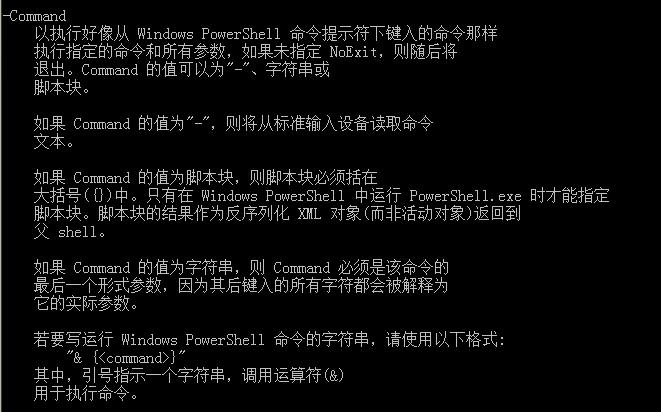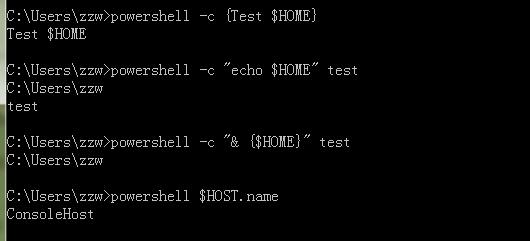前言
背景: 前前段时间,做文件操作处理时,有这么一个场景: window 下需要对某固定目录下的文件及其他文件进行拷贝操作, 至目标对象---> 外置存储设备(U盘或移动硬盘),且需要一定大小的存储量并做判断提示。
问题: 其主要问题不在文件拷贝操作,而是对外置存储设备的处理(主要是对磁盘大小的判断,也就是数字的比较及计算)。首先批处理的数字处理有一定范围(正负 2^31-1),其次超出范围的比较情况还有不同。
解决: 其一则是正面刚(截取操作再比较),其二则是绕过换其他方法(调 PowerShell 处理)
一、使用 bat 做数字比较
1.下图为批处理数字比较的情况:两个值都超出范围的比较,结果相反

2.以下为当时的脚本(后面磁盘大小的计算实在不知道咋怎,用了 PowerShell ):
@echo off & setlocal enabledelayedexpansion
rem =========================================================
rem == The tools develop for copy files to external disk ==
rem == author: by zzw ==
rem == datetime: 2019.07.1 ==
rem =========================================================
@rem chcp 936 ::更换默认编码
@rem 源路径
set srcPath=F:\\zzwTest
@rem 本地磁盘驱动器: C:\\ D:\\ E:\\
:HasDrive
for /f "tokens=1,* delims= " %%i in (\'fsutil fsinfo drives\') do (
set d=%%j
set d=!d:\\=!
@rem echo !d!. 遍历磁盘信息是否包含 移动 字符
for %%a in (!d!) do (
fsutil fsinfo driveType %%a | findstr "移动" >nul && set driver=%%a
)
@rem 移动硬盘会被指定为固定驱动器.需要去除本地磁盘
if not defined driver (
set d=!d:C:=!
set d=!d:D:=!
set d=!d:E:=!
set d=!d: =!
set driver=!d!
if "!d!"=="" ( call :Tip1 ) else ( call :Tip1 ZZW )
)
goto DriverSpace
)
:DriverSpace
if defined driver (
@rem 包含 可用字节总数 的行,取第一行
for /f "tokens=1,2 delims=:" %%i in (\'fsutil volume diskFree %driver% ^|findstr "可用字节总数"\') do (
set free=%%j
@rem echo !free! | findstr "(" && set free=!free:*(=! & set free=!free:^)=! || set free=!free: =!
for /f "tokens=1 delims= " %%x in ("!free!") do (
set free=%%x
)
@rem calculate disk size. multiplier of 1.1
@rem debug: set free=1048576000
if !free! LSS 1126 ( call :Tip3 1 B )
if !free! LSS 1153433 ( call :Tip3 1024 KB )
if !free! LSS 1181116006 ( call :Tip3 1024*1024 MB )
call :Tip3 1024*1024*1024 GB
:Below
@rem 批处理数值范围在正负 2^31-1 = 2147483647
set total=!free!t
if "!total:~10!"=="" (
@rem echo 小于 10 位数 0.93GB=999999999B 0.5GB=536870912B
if "!total:~8!"=="" ( call :Tip2 [10MB] ★★★警告★★★)
if "!total:~9!"=="" ( call :Tip2 [100MB] ★★★警告★★★)
set totalN=!total:~0,9!
if !totalN! LSS 104857600 ( call :Tip2 [100MB] ★★★警告★★★)
if !totalN! LSS 262144000 ( call :Tip2 [250MB] ★★★警告★★★)
if !totalN! LSS 536870910 ( call :Tip2 [500MB] ★★★警告★★★)
call :Tip2 [1GB]
)
if "!total:~10!"=="t" (
@rem echo 等于 10 位数 6GB=6442450944B
set totalA=!total:~0,10!
if !totalA! LSS 1048576000 ( call :Tip2 [1GB] )
if !totalA! LSS 1610612735 ( call :Tip2 [1.5GB] )
if !totalA! LSS 2147483646 ( call :Tip2 [2GB] )
set totalB=!total:~0,9!
if !totalB! LSS 268435456 ( call :Tip2 [2.5GB] )
if !totalB! LSS 322122547 ( call :Tip2 [3GB] )
if !totalB! LSS 429496729 ( call :Tip2 [4GB] )
if !totalB! LSS 536870912 ( call :Tip2 [5GB] )
if !totalB! LSS 644245094 ( call :Tip2 [6GB] )
)
goto ReSelect
)
)
:Tip1
color 0b & echo,
echo 请确保外置 [U盘] 或 [移动硬盘] 插入成功!!!& echo,
if not "%1"=="" ( echo 磁盘识别错误,请联系开发者 ----^> %1& echo, )
goto End
:Tip2
color 0b & echo,
echo 请确保 %driver% 盘空间至少 6GB 可用 & echo,
if not "%2"=="" echo %2
echo 注意 %driver% 盘空间小于 %1 ,不建议继续操作,默认 N
echo 若继续将可能导致部分文件复制失败!!!
echo,
set /p confirm=请确认是否要继续(N/Y)_^>^>
if /i %confirm%==y goto ReSelect
goto End
:Tip3
set /p =◆ %driver% 磁盘可用空间(约)为: <nul
@rem powershell -c "[String]$i=!free!/(%1);if($i.contains(\'.\')) {$s=$i.split(\'.\'); $s[0],$s[1].substring(0,3)+\'%2\' -join(\'.\')} else {$i+\'%2\'}"
powershell -c "[String]$i=!free!/(%1);if($i.contains(\'.\')) {$s=$i.split(\'.\'); $s[0]+\'.\'+$s[1].substring(0,3)+\' %2\'} else {$i+\'%2\'}"
goto Below
:ReSelect
color 0a
echo,
echo *********该工具将拷贝所选目录文件至 %driver% 盘设备********
echo,
echo 请在下列选项中选择需要操作的路径(如: 1 、2 、3 )
echo,
echo ==========================================================
set a=0
for /f %%i in (\'dir /b /ad "%srcPath%"\') do (
set /a a+=1
echo [!a!] %%i
)
echo,
echo ==========================================================
set a=0
set /p number=请输入:
for /f %%i in (\'dir /b /ad "%srcPath%"\') do (
set /a a+=1
if !a!==%number% set testResult=%%i & echo, & echo 你的选择是 %%i
)
if not defined testResult (
color 04
echo,
echo 请选择正确的选项!
echo 请按任意键重新选择!
pause >nul & cls & goto ReSelect
)
echo,
echo "=====可以开始操作了======"
:End
pause
从以上脚本看来,在 cmd 中使用大的数据比较时非常吃力,脚本还一坨一坨的。而 PowerShell 则简单了,请看下列分析及操作操作。
二、CMD 命令行 PowerShell 的使用
在使用前首先来介绍下:
Windows PowerShell 是一种命令行外壳程序和脚本环境,使命令行用户和脚本编写者可以利用 .NET Framework的强大功能 ----->百度百科
1.在cmd 命令行中 powershell /? 先查看简要帮助文档(以下为比较关注信息),这里顺便贴上官方路径

2.若要运行PowerShell 脚本或者命令,可能需要使用 PowerShell 需要开启相关权限,如下操作即可:
@echo off
@rem set the execution mode of the PowerShell
set flag=1
@rem -c 等同 -Command
powershell -c "Get-ExecutionPolicy" |findstr "Restricted" >nul && set flag=0
if %flag% == 0 (
:: powershell -ExecutionPolicy RemoteSigned 与下句等同
powershell -c "Set-ExecutionPolicy RemoteSigned"
echo Allowed to use powershell
)
3.着重实践下重点关注的地方
PowerShell[.exe] [-PSConsoleFile <file> | -Version <version>]
[-NoLogo] [-NoExit] [-Sta] [-NoProfile] [-NonInteractive]
[-InputFormat {Text | XML}] [-OutputFormat {Text | XML}]
[-WindowStyle <style>] [-EncodedCommand <Base64EncodedCommand>]
[-File <filePath> <args>] [-ExecutionPolicy <ExecutionPolicy>]
[-Command { - | <script-block> [-args <arg-array>]
| <string> [<CommandParameters>] } ]
# Command 的值为"-", 将会打印帮助文档 同 powershell -c
powershell -c -
# Command 的值为脚本块,只在 powershell 环境下才有效。
# 而 cmd 下会原样输出,且数据必须在括号中,否则报错
powershell -c {Test $HOME}
# Command 的值为字符串,则该字符串必须是最后一个参数
# 执行字符串中的命令返回结果且输出 test
powershell -c "echo $HOME" test
# 运行 Windows PowerShell 命令的字符串, 不会输出 test
powershell -c "& {$HOME}" test
# 实际发现省略 -c 命令也可以实现(暂未深入研究其原因)
powershell $HOME
结果如图:

三、使用 PowerShell 做数字比较
1.通过上述的帮助文档,就可以愉快的做数字比较和计算了。不过这里还是列一下 PowerShell 的比较运算符,其他还是移步官方文档或文末链接地址查阅。
-eq:等于 -ne:不等于
-gt:大于 -ge:大于等于
-lt:小于 -le:小于等于
-contains:包含 -notcontains:不包含
2.再来看看数字比较和计算,可以发现很方便,既能通过判断自定义显示结果,也能直接显示比较结果。

3.对于最开始的磁盘空间比较计算的问题已经可解决了,但大串的数字写起来还是挺麻烦的,不过 PowerShell 可以识别计算机容量单位, 包括 KB,MB,GB,TB,PB。那么我们就能更加愉快的玩耍了

@echo off
for /f "tokens=1,2 delims=:" %%i in (\'fsutil volume diskFree D:\\ ^|findstr "可用字节总数"\') do (
@rem 计算时会进行四舍五入
@rem 等同 powershell "\'{0:N2}\' -f (%%j/1GB)"
powershell "$s=\'{0:0.00}\' -f (%%j/1GB);$s+\' GB\'"
)
pause
四、调用 PowerShell 的细节及场景
1.调用本质
整体来说在使用批处理时可以通过 PowerShell 来弥补不足。究其调用本质----> 开启一个 PowerShell 进程实现操作结束后退出。如图所示

2.调用细节
本文中的脚本只对调用 PowerShell 的结果进行展示,那如何赋值给变量或管道输出呢?
# 不换行结果显示
set /p =HomePath: <nul
powershell "$HOME"
# 输出值赋给批处理脚本变量
for /f %%i in (\'powershell "1+2"\') do (
set sum=%%i
)
echo 赋值结果:%sum%
# 管道输出给批处理的其他命令
powershell $HOST | findstr /i name
# 批处理参数传给 PowerShell 使用
set total=100
powershell "\'平均值为: \'+ %total%/10"
3.其他场景
批处理运行时弹框选项【powershell 弹框】
@echo off
echo After 3 seconds, the prompt box will appear...
timeout /t 3 >nul
set pscommand=\'powershell "$IP=ForEach($ip in (ipconfig) -like \'*IPv4*\'){\'IP Address:\'+($ip -split \' : \')[-1]};$showIp=New-Object -ComObject WScript.Shell;$showIp.popup(\\"$IP\\",0,\'ShowIP\',1+64)"\'
for /f %%i in (%pscommand%) do (
if %%i==1 ( echo You selected the OK button )
if %%i==2 ( echo You selected the CANCEL button )
)
pause
批处理调用执行 PowerShell 脚本文件
powershell -File .\\run.ps1
未完,待续...